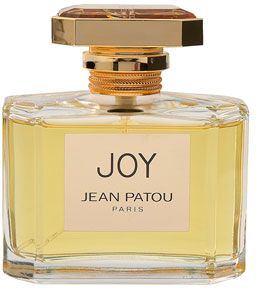
#Jean patou joy parfum flacon full
So delicious, I have to say that with the exception of perhaps one other, this is my favorite perfume in the world!! Full and unused. It comes with both of its original presentation boxes. Offered here is a beautiful one fifth ounce of the inimitable JOY. The luxurious composition is coveted by women around the world. JOY is a simply joyous perfume! It stands out as one of the world's greatest perfumes ever!! It is still known as the costliest perfume in the world, but more so in numbers of rose petals and jasmine flowers! Renowned as "the costliest perfume in the world," one ounce of the lavish scent contains 10,600 jasmine flowers and 28 dozen May roses. Heart notes are Jasmine, Bulgarian Rose, May Rose, and Irisīase notes are Musk, Sandalwood, Ambergris, and Civet

Top notes are Aldehydes, Tuberose, Ylang Ylang, Pear, Peach, and Green Notes In 1932 Jean Patou designed a small black and red bottle in which this perfume is also presented. Regardelss of its simplicity, the bottle leaves an impression of luxury and hints that its content is one of the best perfumes of the world. The bottle, of simple and straight lines with a golden thread around its neck, was designed by the architect Louis Süe in 30ml, 50ml and 100ml sizes for Eau de Parfume and 30ml and 50ml sizes for Eau de Toilette. The base whiffs with sensual musk, warm and milky-powdery sandalwood, with mild musky civet tones. The heart beats passionately in pure and sweetly fresh jasmine notes, seductive and balmy spicy and darkened iris root. The composition starts with fragrant jilt tuberose, luscious rose, ylang-ylang blossom, aldehydes, sweet and mouthwatering pear, and green notes. Intense and luscious with alluring floral composition, JOY was created by Henri Alméras, who made its top notes irresistibly delightful. With the time JOY attains enormous success and became the second best selling perfume of all times (the first best-selling is the legendary Chanel N★). JOY is created of rare flowers in unique concentration of 10600 flowers of jasmine and 28 dozens of roses which adorn the exceptional heart of this perfume. It was presented by Jean Patou as 'the world's most expensive perfume' right at the time of The Great Depression in 1929, when the market of luxury fashion crushed and Jean Patou's house could survive only through the perfumes. JOY was created with a lot of care, just like the most expensive Haute-Cotture dress, and thus it was extraordinary and timeless. It is considered to be one of the greatest fragrances created and is a landmark example of the floral genre in perfumery. JOY is a perfume created for Parisian couturier Jean Patou by perfumer Henri Alméras in 1929. In 1927, Jean Patou also delighted women with the introduction of Huile de Chaldée, the world’s first suntan oil. His debut perfumes were designed to complement women with a particular hair colour: Que Sais-Je? was for brunettes, Amour Amour was for blondes, and Adieu Sagesse was for redheads. The highly social writer Anita Loos called it ‘the most elegant place in which to greet the Paris dawn'.įrom 1925, Jean Patou was also creating the most desirable of perfumes. It was named Le Jardin de Ma Soeur (My Sister's Garden).

Jean Patou opened a nightclub, with fellow designer Edward Molyneux.

and to show off brazenly bare legs, in short hemlines. clothes designed to move, to flutter, to flirt gorgeously. But in 1919, Patou returned to Paris, and did indeed launch a collection, including long-waisted shepherdess dresses. Sadly, his first collection had to be mothballed: Jean Patou left Paris to serve as a captain in the French Zouave regiment, fighting as far afield as Anatolia. And in 1914, just before the war broke out, he established his own couture house. And it was his father who taught Jean Patou all about color.Īfter going to work for an uncle in the fur trade, Jean Patou launched his own venture as a dressmaker and furrier, moving into tailoring. He was born in 1887, in Normandy, where Jean Patou‘s father was a renowned leather tanner, known for his bookbinding skills. No longer corseted, bound by convention or whalebone ‘stays’, there was a spirit of freedom in the air. When couturier Jean Patou arrived on the Paris scene, in the 1920s, the world was changing.


 0 kommentar(er)
0 kommentar(er)
